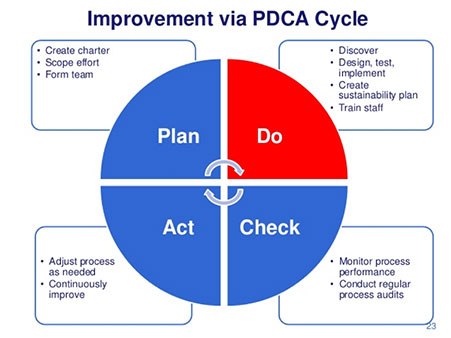How a Continuous Improvement Process Drives Results – Why 1% Wins Every Time
5 minutes, 30 seconds read

Implementing a continuous improvement process can benefit every aspect of your business. Making a conscious effort to improve products, services, and company culture is a sure-fire way to drive financial results. But striving for process improvements doesn’t need to involve a radical overhaul of your systems. It’s completely possible (and often preferable) to aim for incremental improvements over a long period of time. By following this methodology, you don’t need to turn your back on what you’re already doing – just identify tweaks that can be made on a consistent basis.
Making small scale incremental improvements can lead to sustained and scalable growth. It’s sometimes referred to as the ‘1% infinity’ concept because there’s no limit to how much you can improve. No matter which industry you work in, it’s possible to improve a little bit every day on a consistent and ongoing basis. In this article, we look at how continuous improvement can drive meaningful results in your business.
The Benefits of Continuous Improvement
If this topic is new to you, then it’s normal to ask what the value of the continuous improvement process is. Doesn’t it just create more administrative work and red tape? But the reality is that an improvement program is designed to make things more efficient, not harder work. By definition, its purpose is to make things better, whether that’s in terms of safety, quality, or financial results. The benefits of implementing a continuous improvement process include;
- Boosts productivity – reduces QA issues and related product returns to increase overall output.
- Improves product & service quality – leading to more satisfied customers and more referrals.
- Creates a competitive advantage – give your organization an edge over others in your industry.
- Encourages grassroots input – every idea is valued, whether from a frontline team member or managing director.
- Improves company culture – empowers employees to make a difference, creating a shared sense of fulfillment.
- Increases teamwork – helps remove departmental silos and increase collaboration.
- Enhances creativity – challenges staff to solve problems and think outside the box.
One of the most famous continuous improvement examples is that of Toyota in Japan. They implemented the Kaizen process on their production line and would shut it down whenever a problem was encountered. The staff would immediately brainstorm and implement solutions to avoid the issue arising again. This process lead Toyota’s product quality, efficiency, and profitability increasing over time.
Incremental Improvement = Breakthrough Improvement
You might be wondering how much difference small incremental improvements really make. After all, isn’t it better to go for the big wins rather than smaller achievements? But the reality is that these small changes add up to a much more substantial impact on performance than one or two large breakthrough improvement changes. The incremental steps also drive a sensible approach. Without tackling the underlying issues that contribute to a problem, it’s much harder to deliver sustained improvement. After all, you can’t build a solid house on rocky foundations. So, it’s important not to dismiss incremental improvement as any less valuable, because it contributes to the breakthroughs that really move the lever.
Continuous Improvement Tools
There are lots of different approaches that you can use to implement an improvement process. The PDCA cycle, Deming cycle, Six Sigma, Genchi Genbutsu and Kanban are just a few improvement techniques. These all promote their own tools for implementation, such as checklists, process charts, and instruction manuals. For most businesses, the PDCA (Plan Do Check Act) is easiest to implement as it requires minimal training and is easily understood by staff in different roles. There’s no need to buy into ongoing courses and team member certifications since you can apply common sense to implement it.
Continuous Improvement Process Steps
Successful implementations of improvement models usually follow some simple steps. It doesn’t need to be a complex process, just one that works within the systems of your business. Whichever of the continuous improvement models you go with, it’s important that you can tailor it to your needs. If you opt for the PDCA approach, then you can break down the actions into four basic steps:
- Plan – identify objectives and how best to implement the project.
- Do – carry out the activities to implement it.
- Check – Once executed, check the results to ensure they align with expectations.
- Act – If any improvement areas are identified then implement them.
This type of business process management delivers long-term improvements for a company. Whether the result of your initiative improves quality, drives engagement, or reduces waste, it’s contributing to the future success of your business. Improving products, services, or processes will gradually lead to increased sales and greater efficiency. So, by implementing a continuous improvement culture, you can ensure the sustained success of your company.
How We Can Help
Rever is all about sharing and reusing, doing and tracking. Continuous improvement becomes a hundred times easier with our innovative digital platform. Using the Rever dashboard, you can monitor the performances of teams, understand their impact, and easily identify the people making the biggest difference at your company.
The Rever Cycle is our version of the PDCA methodology that guides teams on the exact steps to follow to execute their own ideas and achieve continuous improvement. It allows them to capture the entire process, from identifying a problem to experimenting and implementing a solution. They can use it to capture the before and after with pictures, notes and drawings, making their ideas a reality in no time. The time of your team is too valuable to be wasted in handmade drawings and complex explanations.
At Rever, we believe that anybody can be a knowledge worker, contribute to the organization’s success and thrive in their work through their contribution. What makes us human is the capacity to grow our intellect and will, and to use them for good. We observe, especially at work, that most people are asked to stop thinking and do as they are told. We want to change that. We enable people to achieve their full creative potential.
Interested in learning more or implementing your own continuous improvement process? Then request a demo with one of our friendly team.
Like this content? Sign up for our Newsletter
[hubspot type=form portal=561211 id=fda6d445-739e-4072-8dae-68b94971a266]THE FRONTLINE DOJO
More Articles
How to develop the next billion Knowledge Workers
3 minutes, 51 seconds read
Digital transformation in manufacturing is not what you think it is
10 minutes, 36 seconds read
The human side of change management: lessons learned from Toyota, Airbus, and Silicon Valley
1 minute, 28 seconds read
The true meaning of Genchi Genbutsu
3 minutes, 5 seconds read
